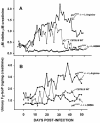Inducible nitric oxide synthase regulates production of isoprostanes in vivo during chlamydial genital infection in mice
- PMID: 14638813
- PMCID: PMC308939
- DOI: 10.1128/IAI.71.12.7183-7187.2003
Inducible nitric oxide synthase regulates production of isoprostanes in vivo during chlamydial genital infection in mice
Abstract
Urinary nitrite and F(2)-isoprostanes, an index of oxidant stress, were elevated during chlamydial genital infection of mice. Enhancement of urinary nitrite and F(2)-isoprostanes was observed in phagocyte oxidase-deficient mice. Inhibition of inducible nitric oxide synthase reduced isoprostane excretion. We conclude that nitrogen radicals induce F(2)-isoprostane production and excretion during murine chlamydial genital infection.
Figures


Similar articles
-
Role for inducible nitric oxide synthase in protection from chronic Chlamydia trachomatis urogenital disease in mice and its regulation by oxygen free radicals.Infect Immun. 2001 Dec;69(12):7374-9. doi: 10.1128/IAI.69.12.7374-7379.2001. Infect Immun. 2001. PMID: 11705910 Free PMC article.
-
Chlamydial infection in inducible nitric oxide synthase knockout mice.Infect Immun. 1998 Apr;66(4):1282-6. doi: 10.1128/IAI.66.4.1282-1286.1998. Infect Immun. 1998. PMID: 9529043 Free PMC article.
-
Neither interleukin-6 nor inducible nitric oxide synthase is required for clearance of Chlamydia trachomatis from the murine genital tract epithelium.Infect Immun. 1998 Mar;66(3):1265-9. doi: 10.1128/IAI.66.3.1265-1269.1998. Infect Immun. 1998. PMID: 9488425 Free PMC article.
-
Animal models for the study of Chlamydia trachomatis infections in the female genital infection.Drugs Today (Barc). 2006 Mar;42 Suppl A:55-63. Drugs Today (Barc). 2006. PMID: 16683045 Review.
-
Nitric oxide synthases and tubal ectopic pregnancies induced by Chlamydia infection: basic and clinical insights.Mol Hum Reprod. 2010 Dec;16(12):907-15. doi: 10.1093/molehr/gaq063. Epub 2010 Jul 20. Mol Hum Reprod. 2010. PMID: 20647263 Free PMC article. Review.
Cited by
-
Role of activins and inducible nitric oxide in the pathogenesis of ectopic pregnancy in patients with or without Chlamydia trachomatis infection.Clin Vaccine Immunol. 2009 Oct;16(10):1493-503. doi: 10.1128/CVI.00221-09. Epub 2009 Aug 19. Clin Vaccine Immunol. 2009. PMID: 19692623 Free PMC article.
-
Enhancement of intracellular gamma-tocopherol levels in cytokine-stimulated C3H 10T1/2 fibroblasts: relation to NO synthesis, isoprostane formation, and tocopherol oxidation.BMC Chem Biol. 2007 Jul 3;7:2. doi: 10.1186/1472-6769-7-2. BMC Chem Biol. 2007. PMID: 17608946 Free PMC article.
-
Inducible nitric oxide synthase inhibitors reduce urinary markers of systemic oxidant stress in murine proliferative lupus nephritis.J Investig Med. 2005 Nov;53(7):347-52. doi: 10.2310/6650.2005.53705. J Investig Med. 2005. PMID: 16297360 Free PMC article.
-
The Role of the Oxidative State and Innate Immunity Mediated by TLR7 and TLR9 in Lupus Nephritis.Int J Mol Sci. 2023 Oct 16;24(20):15234. doi: 10.3390/ijms242015234. Int J Mol Sci. 2023. PMID: 37894915 Free PMC article. Review.
-
Cardiovascular consequences when nitric oxide and lipid signaling converge.Circ Res. 2009 Sep 11;105(6):511-22. doi: 10.1161/CIRCRESAHA.109.202077. Circ Res. 2009. PMID: 19745170 Free PMC article. Review.
References
-
- Allione, A., P. Bernabei, M. Bosticardo, S. Ariotti, G. Forni, and F. Novelli. 1999. Nitric oxide suppresses human T lymphocyte proliferation through IFN-gamma-dependent and IFN-gamma-independent induction of apoptosis. J. Immunol. 163:4182-4191. - PubMed
-
- Clark, S., M. Coffey, R. Maclean, P. Collins, M. Lewis, A. Cross, and V. O'Donnell. 2002. Characterization of nitric oxide consumption pathways by normal, chronic granulomatous disease and myeloperoxidase-deficient human neutrophils. J. Immunol. 169:5889-5896. - PubMed
-
- Cotter, T. W., Q. Meng, Z. Shen, Y. Zhang, H. Su, and H. D. Caldwell. 1996. Protective efficacy of major outer membrane protein specific immunoglobulin A (IgA) and IgG monoclonal antibodies in a murine model of Chlamydia trachomatis genital tract infection. Infect. Immun. 63:4704-4714. - PMC - PubMed
-
- Cracowski, J. L., T. Durand, and G. Bessard. 2002. Isoprostanes as a biomarker of lipid peroxidation in humans: physiology, pharmacology and clinical implications. Trends Pharmacol. Sci. 23:360-366. - PubMed
Publication types
MeSH terms
Substances
Grants and funding
LinkOut - more resources
Full Text Sources

